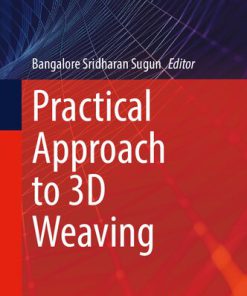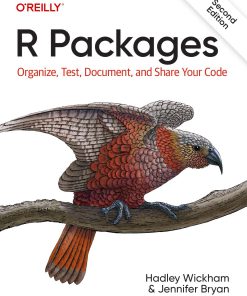Craft Your Code 2nd Edition by Srihari Sridharan ISBN B0CR7FRGNP 9798892332804
$50.00 Original price was: $50.00.$25.00Current price is: $25.00.
Craft Your Code 2nd Edition by Srihari Sridharan – Ebook PDF Instant Download/Delivery: B0CR7FRGNP ,9798892332804
Full download Craft Your Code 2nd Edition after payment

Product details:
ISBN 10: B0CR7FRGNP
ISBN 13: 9798892332804
Author: Srihari Sridharan
Craft Your Code 2nd Edition Table of contents:
Part I: Mastering the Fundamentals
Chapter 1: The Significance of Coding Standards: Building Solid Foundations
-
What is a coding standard?
-
The Significance of Coding Standards
-
Identifying Code Smells
-
Indicators of Deteriorating Design
-
A Quick Note on Static Code Analyzers
-
Upcoming Chapter
Chapter 2: Unveiling the Power of Names
-
The Significance of Naming in Programming
-
Specificity in Variable Names
-
Enhancing Names of Loop Index Variables
-
Simplifying Names
-
Adding Context to Names
-
Coding in the Language of the Domain
-
Maximizing Clarity and Minimizing Ambiguity
-
Upcoming Chapter
Chapter 3: Essence of Aesthetics
-
Why is Aesthetics Important?
-
Quick Note on Code Layout
-
Improving Aesthetics – An Example
-
Reducing Noise in Code
-
Vertical Formatting
-
Horizontal Formatting
-
Individual vs. Team: Striving for Consistency
-
Useful Tools
-
Upcoming Chapter
Chapter 4: Comments: The Bridge Between Code and Understanding
-
Importance and Necessity of Comments
-
Recording thoughts throughout the coding process
-
Enhancing Code Readability with Comments
-
Mastering Precision and Conciseness in Code Comments
-
Closing Remarks
-
Upcoming Chapter
Chapter 5: Simplifying Control Flow – Keep It Simple and Streamlined (KISS)
-
Chapter Overview
-
Optimizing Conditional Expressions: Leveraging Argument Order for Readability
-
Harnessing the Power of the Conditional (Ternary ?:) Operator
-
Improving Code Readability with Early Method Exits
-
End of Part I
Part II: Mastering Control Flow and Programming Paradigms
Chapter 6: Practical Strategies for Handling Large Expressions
-
The Power of Explanatory Variables
-
Applying De-Morgan’s Law in Coding
-
Enhancing Readability with Summary Variables
-
DRY – Don’t Repeat Yourself
-
Eliminate Duplication through Function Extraction
-
Summary
-
Upcoming Chapter
Chapter 7: Unlocking Readability: Tips for Clear and Understandable Code
-
Striking a balance between variables and readability
-
Streamlining code by eliminating intermediate results
-
Streamlining code by eliminating control flow variables
-
Harnessing the power of JavaScript closures
-
Optimizing readability by moving declarations close to usage
-
Realizing the benefits of immutability
-
Upcoming Chapter
Chapter 8: Enforcing Code Cohesion: The Law of Demeter Explained
-
Design violating the Law of Demeter
-
Design adhering to the Law of Demeter
-
Upcoming Chapter
Chapter 9: Functional Programming
-
What is functional programming?
-
What is referential transparency?
-
First-class and higher-order functions
-
Pure functions
-
Coding Styles in various languages
-
Incorporating Functional Programming into Non-Functional Languages
-
Crafting functional code
-
Summary
-
Upcoming Chapter
Chapter 10: Object-Oriented Programming
-
Classes, Objects, and Interfaces
-
Key Concepts
-
Summary
-
End of Part II
Part III: Revamping Your Codebase
Chapter 11: Breaking Down Problems: A Divide and Conquer Approach
-
Utilizing Utility Code for Consistency and Efficiency
-
Extracting Project-Specific Functionality
-
Refactoring and Simplifying an Interface
-
A Note of Caution!
-
Upcoming Chapter
Chapter 12: Focusing on One Responsibility at a Time
-
Example – Order Processing
-
Upcoming Chapter
Chapter 13: From Mind to Machine: The Path of Translating Thoughts to Code
-
Improving Clarity
-
Don’t Reinvent the Wheel
-
Knowing Language Features
-
Knowing Features Provided By Libraries
-
Upcoming Chapter
Chapter 14: Less is More: The Elegance and Effectiveness of “No Code”
-
YAGNI
-
Questioning and Evaluating Requirements or Problems
-
Keeping a Watchful Eye on Codebase Size
-
Getting Acquainted with Libraries and Codebase
-
Upcoming Chapter
Chapter 15: Reviewing Code: Examining, Refining, and Elevating Quality
-
The Significance of the Code Review Process
-
Evolution of the Code Review Process
-
Enhancing Code Quality through Collaborative Excellence: Pair Programming and Code Reviews
-
Team Code Reviews
-
Code Review Checklist
-
Categorizing Code Review Comments
-
Sustaining the Progress
-
Tips and Tricks
-
Leveraging Pre-Commit Hooks
-
Summary
-
Upcoming Chapter
Chapter 16: The SOLID Foundations: Writing Code that Stands the Test of Time
-
Credits
-
Introduction
-
Single Responsibility Principle
-
Open-Closed Principle
-
Liskov Substitution Principle
-
Interface Segregation Principle
-
Dependency Inversion Principle
-
Conclusion
-
Upcoming Chapter
Chapter 17: Cohesion and Coupling: Guiding Principles for Modular Code
-
Credits
-
Introduction
-
Cohesion
-
Coupling
-
Package Architecture Principles
-
Package Cohesion Principles
-
The Package Cohesion Tug of War
-
Package Coupling Principles
-
An Important Note
-
End of Part III
Part IV: Beyond the Basics
Chapter 18: A Systematic Approach to Refactoring
-
Quick introduction to refactoring
-
Prerequisites
-
Refactoring in action
-
Handling method-level code smells
-
Handling class-level code smells
-
Handling application-level code smells
-
Iterative approach to refactoring
-
End to end tests for UI Refactoring
-
Distill the Core Domain from Your Legacy App
-
Conclusion
Chapter 19: Test-Driven Development
-
Introduction
-
What is TDD?
-
Red – Green – Refactor
-
Writing Effective Tests
-
Environment Setup
-
Requirements
-
Writing your first test (before writing actual code)
-
RED
-
GREEN
-
RED #2
-
GREEN #2
-
RED #3
-
GREEN #3
-
REFACTOR
-
More tests to cover edge cases
-
Exploring further using TDD
Chapter 20: Sustainable Unit Tests and TDD
-
Observing unit tests
-
Improving test readability
-
Building the test data
-
Summary
Chapter 21: Version Control Strategies
-
Helpful Version Control Practices
-
A possible version control strategy
-
Command-line vs. GUI based tools
-
Trunk Based Development
-
Summary
Chapter 22: Feature Toggles and Clean Code
-
What are feature toggles?
-
Identifying Appropriate Use Cases for Feature Toggles
-
Categories of feature toggles
-
Implementation considerations
-
Toggle configuration and approaches for managing toggle configuration
-
Overriding toggle configuration
-
Best Practices for Working with Feature Toggles
-
Managing the Cost of Feature Toggles
-
Buy vs. Build
-
Inputs to and outputs from an enterprise feature flagging platform
-
Summary
Chapter 23: Handling Technical Debt
-
People
-
Process
-
Software Tools
-
A final note of caution
Chapter 24: Craft Your Career
-
Monitoring and Evaluating Progress
-
Creating Content and Enhancing Your Reputation
-
The Triangle of Technical Knowledge
-
Learning and Note-Taking
-
Career Tips from Experience
-
Becoming a generalizing-specialist?
-
Crafting an Impressive Resume
-
Summary
Architects’ Bookshelf
Appendix: Comprehensive Reference
-
Appendix A: What did they say?
-
Appendix B: Code Smells
-
Appendix C: Broken Windows Theory
-
Appendix D: Cost of Owning Technical Debt
-
Appendix E: Recollecting the Boys Scout Rule
-
Appendix F: Philosophies for Effective Programming
-
Appendix G: The 30 seconds rule explained!
-
Appendix H: Object-Oriented Programming Terminology
People also search for Craft Your Code 2nd Edition:
secret code craft
scratch code your hero
craft of survival code
craft your life rp minecraft
r crafts
Tags: Srihari Sridharan, Code, Craft
You may also like…
Fiction - Contemporary Fiction
Computers - Organization and Data Processing
Computers - Programming
Uncategorized
Engineering
Uncategorized
Security as Code 1st Edition by Bk Sarthak Das, Virginia Chu ISBN 9781098127459 1098127455
Computers - Programming











